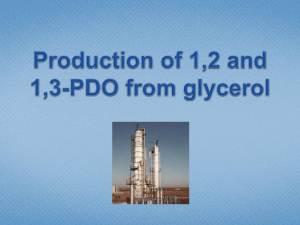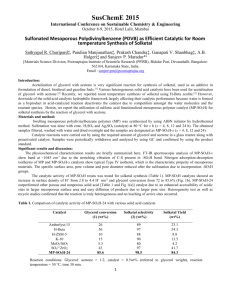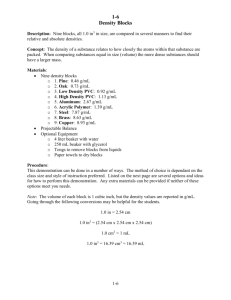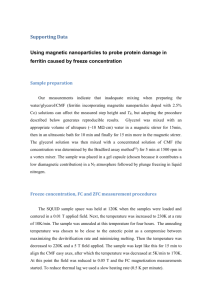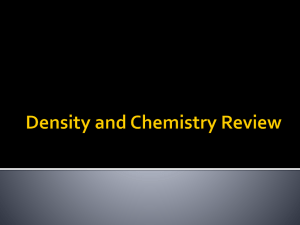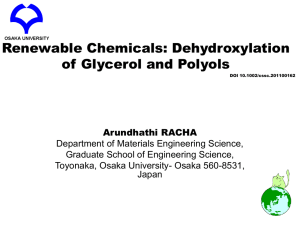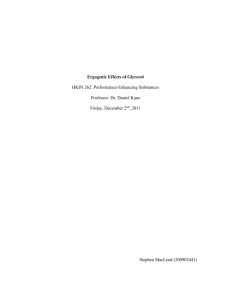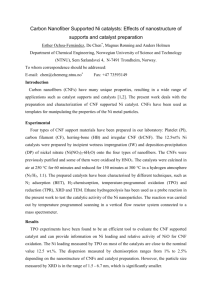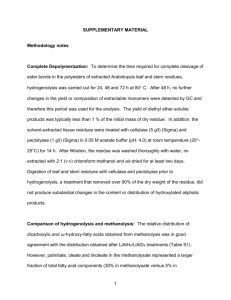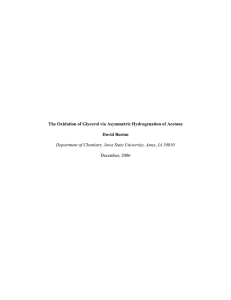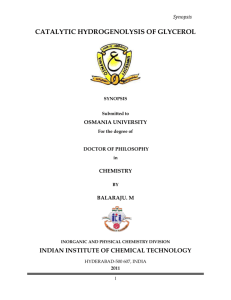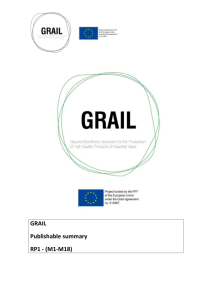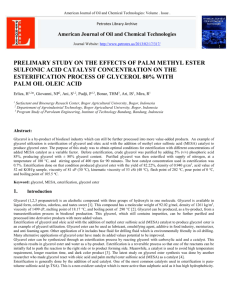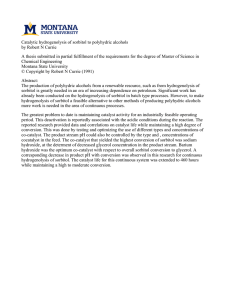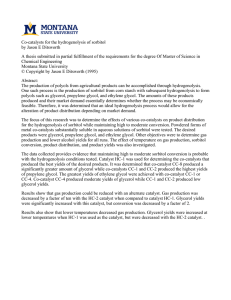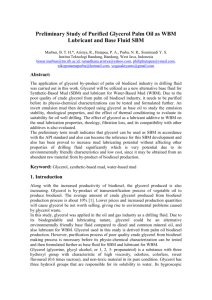300715150622SusChemE_2015Abstract[RMane
advertisement
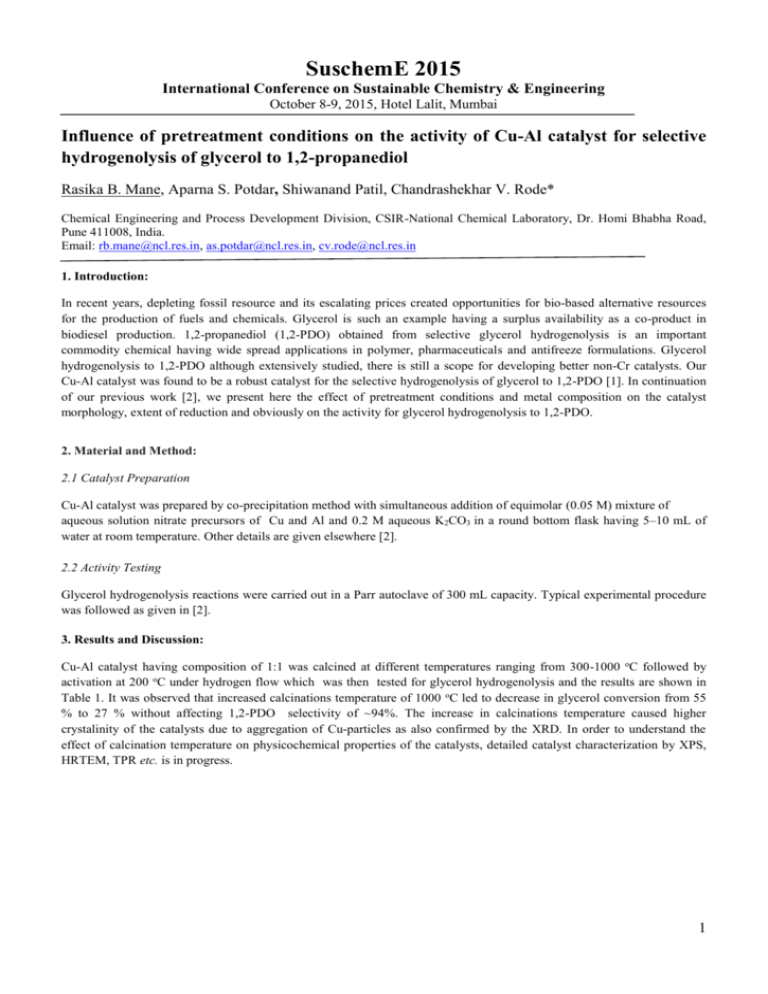
SuschemE 2015 International Conference on Sustainable Chemistry & Engineering October 8-9, 2015, Hotel Lalit, Mumbai Influence of pretreatment conditions on the activity of Cu-Al catalyst for selective hydrogenolysis of glycerol to 1,2-propanediol Rasika B. Mane, Aparna S. Potdar, Shiwanand Patil, Chandrashekhar V. Rode* Chemical Engineering and Process Development Division, CSIR-National Chemical Laboratory, Dr. Homi Bhabha Road, Pune 411008, India. Email: rb.mane@ncl.res.in, as.potdar@ncl.res.in, cv.rode@ncl.res.in 1. Introduction: In recent years, depleting fossil resource and its escalating prices created opportunities for bio-based alternative resources for the production of fuels and chemicals. Glycerol is such an example having a surplus availability as a co-product in biodiesel production. 1,2-propanediol (1,2-PDO) obtained from selective glycerol hydrogenolysis is an important commodity chemical having wide spread applications in polymer, pharmaceuticals and antifreeze formulations. Glycerol hydrogenolysis to 1,2-PDO although extensively studied, there is still a scope for developing better non-Cr catalysts. Our Cu-Al catalyst was found to be a robust catalyst for the selective hydrogenolysis of glycerol to 1,2-PDO [1]. In continuation of our previous work [2], we present here the effect of pretreatment conditions and metal composition on the catalyst morphology, extent of reduction and obviously on the activity for glycerol hydrogenolysis to 1,2-PDO. 2. Material and Method: 2.1 Catalyst Preparation Cu-Al catalyst was prepared by co-precipitation method with simultaneous addition of equimolar (0.05 M) mixture of aqueous solution nitrate precursors of Cu and Al and 0.2 M aqueous K2CO3 in a round bottom flask having 5–10 mL of water at room temperature. Other details are given elsewhere [2]. 2.2 Activity Testing Glycerol hydrogenolysis reactions were carried out in a Parr autoclave of 300 mL capacity. Typical experimental procedure was followed as given in [2]. 3. Results and Discussion: Cu-Al catalyst having composition of 1:1 was calcined at different temperatures ranging from 300-1000 oC followed by activation at 200 oC under hydrogen flow which was then tested for glycerol hydrogenolysis and the results are shown in Table 1. It was observed that increased calcinations temperature of 1000 oC led to decrease in glycerol conversion from 55 % to 27 % without affecting 1,2-PDO selectivity of ~94%. The increase in calcinations temperature caused higher crystalinity of the catalysts due to aggregation of Cu-particles as also confirmed by the XRD. In order to understand the effect of calcination temperature on physicochemical properties of the catalysts, detailed catalyst characterization by XPS, HRTEM, TPR etc. is in progress. 1 Table 1: Effect of calcinations temperature on activity of Cu-Al catalyst for glycerol hydrogenolysis Sr. No. 1 Calcination temp. (oC) 300 Conversion (%) 55 1,2 -PDO 93 Selectivity (%) Acetol EG 0.4 6 2 400 47 94 0.2 3 4 5 700 800 1000 52 42 27 93 93 94 0.3 1 1.5 IPA 0.7 Others 0.17 6 0.8 0.14 6 5.5 4.1 0.1 0.8 0.9 0.9 0.9 0.6 Reaction condition: Glycerol, 20g; water: 80g; catalyst, 1g; temperature, 220 0C; agitation speed; 1000 rpm; H2 pressure, 750 psi; reaction time, 5h. 4. Conclusions: As the higher calcination temperature leads to enhanced Cu particle aggregation giving lower activity, the lower calcination temperature of 300-400 oC is favourable for the optimum glycerol conversion and 1,2-PDO selectivity. Further detailed studies on effect of activation temperature, digestion time, and Cu-Al composition need to be carried out. 5. References: 1. R. B. Mane, C.V. Rode, Green Chem., 14, 2012, 2780-2789. 2. R. B. Mane, C. V. Rode, Org. Proc. Res. Dev., 16 (5), 2012, 1043-1052. 2

